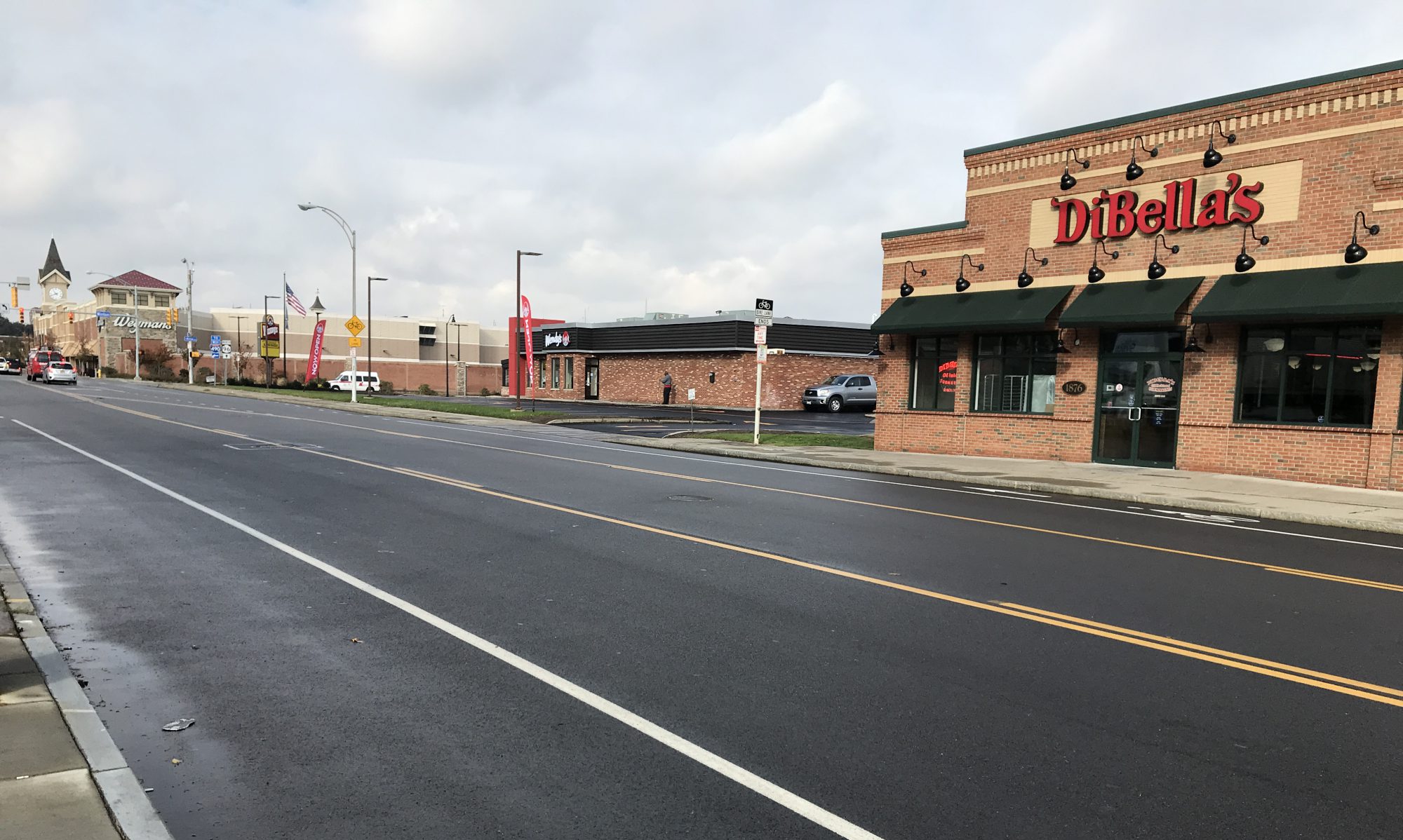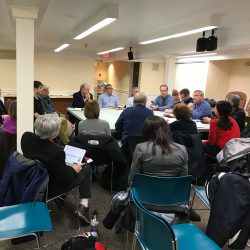Bike Lanes On East Avenue: A Primer
Timeline
| Date | Description |
| November 2, 2017 | NYS DOT hosts informational meeting at Allens Creek Elementary School |
| November 21, 2017 | Brighton Town Board Member Elect Robin Wilt utilizes the public comments section of the Brighton Town Board meeting to advocate for 5-foot bike lanes on East Avenue |
| December 7, 2017 | Pittsford Town Supervisor Bill Smith letter to Kevin Bush, advocating for 5-foot-wide bike lanes on East Avenue. |
| December 11, 2017 | Numerous citizens address the Pittsford Town Board in support of bike lanes on East Avenue. |
| December 13, 2017 | Robin Wilt, Brighton Board Member-Elect, writes letter to the Brighton Town Board in support of 5-foot bike lanes on East Avenue. |
| December 13, 2017 | Color Brighton Green drafts a letter to the Brighton Town Board in support of bike lanes in the project |
| December 15, 2017 | Stephanie Townsend, Pittsford Board Member-Elect, drafts letter to Kevin Bush, Regional Director of NYS DOT |
| December 19, 2017 | Meeting with Arleigh Roselene of Majority Leader Joe Morelle’s office |
| January 3, 2018 | Meeting with Kevin Bush, hosted by Pittsford Town Supervisor Bill Smith |
| January 5, 2018 | Meeting with State Senator Joe Robach, Chair of the Senate Transportation Committee |
| February 6, 2018 | Brighton Town Board sends letter to DOT in support of 5-foot bike lanes |
Background
On November 2, 2017, the New York State Department of Transportation (NYS DOT) hosted a meeting to discuss planned improvements to upgrade Route 96 (East Avenue) in the summer of 2018, including a so-called “road diet”:
To improve traffic flow, pavement markings will be changed to accommodate one travel lane in each direction, a center turn lane and shoulders, as opposed to the two lanes in each direction that currently exist.
The plans shared at this meeting showed three lanes, each 11 feet wide, with 3½-foot shoulders on each side. The predominant feedback from the public was that DOT should provide for “real” bike lanes, marked for bike access with the familiar icons stenciled into the roadway. Since Nazareth College and St. John Fisher College are both accessible from the city by this roadway, one anticipated usage would be for college students to use these bike lanes to commute to and from the city.
Federal regulations for bike lanes stipulate a minimum width of 5 feet, and the roadway is 40 feet wide. To accommodate 5-foot bike lanes, all three lanes (two travel and one center turn lane) would have to be reduced to 10 feet in width – the same width as the four lanes that have been in place for decades.
Brighton Town Supervisor Bill Moehle, Pittsford Town Supervisor Bill Smith, Pittsford Town Councilmember Stephanie Townsend, and Brighton Town Councilmember Robin Wilt sent letters in support of bike lanes to Kevin Bush, the DOT Regional Director in charge of the project. In turn, the DOT has agreed to revise the design to provide for wider, 4½-foot wide shoulders by making the travel lanes 10 feet wide, as they are for the current four-lane configuration. The center turn lane, according to Mr. Bush, must be at least 11 feet wide according to NYS DOT standards.
The standard being cited by NYS DOT, however, may be in need of revision. Recent studies correlating lane width against accident rates suggest that narrower traffic lanes are safer for motorists. See for example, this summary article in CityLab, which references a paper presented at the Canadian Institute of Transportation Engineers (CITE) entitled “Narrower Lanes, Safer Streets” that examined accident rates in Toronto and Tokyo. From the conclusion:
Given the empirical evidence that favours ‘narrower is safer’, the ‘wider is safer’ approach based on intuition should be discarded once and for all. Narrower lane width, combined with other livable streets elements in urban areas, result in less aggressive driving and the ability to slow or stop a vehicle over shorter distances to avoid a collision.
In the months since the November 2 meeting, we have engaged with DOT to persuade them that for the planned East Avenue “road diet,” narrower traffic lanes would be a “win-win” for bicyclists and motorists alike: it would simultaneously provide for a correctly-demarcated bike lane and a safer roadway for motorists.
On December 19, 2017, a small number of representatives met with Arleigh Roselene of Assembly Majority Leader Joe Morelle’s office. Mr. Roselene wanted to know if a “compromise” could be reached between the 3½-foot and 5-foot shoulder for the bike lanes. The representatives emphasized that because narrower traffic lanes make for safer conditions for motorists, we did not perceive any conflict between bike lanes and motor vehicle lanes that would require compromise.
On January 3, 2018, Pittsford Town Supervisor Bill Smith hosted a meeting of more than 20 concerned citizens with Kevin Bush and other representatives from NYS DOT. The DOT representatives flatly rejected the idea of a 5-10-10-10-5 configuration, citing the NYS DOT highway standard and also signaling ideological opposition – the “intuition” mentioned in the conclusion of the CITE paper.
Perversely, the NYS DOT personnel even argued that bike lanes could be a detriment to bicyclists. State law requires that bicyclists use bike lanes when available; the argument goes that since bicyclists lose the “right to the roadway,” they would incur liability if they were forced out of the bike lane and into the roadway by an obstruction.
This argument overlooks the provisions that state law already makes for bicyclists who must depart their bike lanes. Here is the full text of Vehicle Traffic Law (VTL) 1234(a), which devotes about half of its text to the exceptions that may prompt bicyclists to depart their bike lanes:
Upon all roadways, any bicycle or in-line skate shall be driven either on a usable bicycle or in-line skate lane or, if a usable bicycle or in-line skate lane has not been provided, near the right-hand curb or edge of the roadway or upon a usable right-hand shoulder in such a manner as to prevent undue interference with the flow of traffic except when preparing for a left turn or when reasonably necessary to avoid conditions that would make it unsafe to continue along near the right-hand curb or edge. Conditions to be taken into consideration include, but are not limited to, fixed or moving objects, vehicles, bicycles, in-line skates, pedestrians, animals, surface hazards or traffic lanes too narrow for a bicycle or person on in-line skates and a vehicle to travel safely side-by-side within the lane. (emphasis added)
On January 5, 2018, representatives met with State Senator Joe Robach, chair of the Senate Transportation Committee. Mr. Robach had heard some of the counterarguments referenced above, and an active discussion ensued. Mr. Robach requested more time to investigate the matter. He was left with copies of letters in support of bike lanes and a copy of the CITE paper.
On February 6, 2018, the Brighton Town Board signed a letter to NYS DOT in support of the 5-foot bike lanes.
County Standards
During the January 3 meeting hosted by Bill Smith, Kevin Bush and other NYS DOT personnel evinced skepticism about their revised plan (10-foot travel lanes with the 11-foot center turn lane), even referring to the compromise proposal as “almost a pilot project.” But, to our astonishment, we have since discovered that Monroe County has been building roads to the standard we are proposing! County-funded roads have been and are being built with 10-foot center turn lanes. As a result, we are in a position to do a study akin to the CITE paper, using local Monroe County traffic data instead of data from Toronto and Tokyo. One possible result of such a study would be to revise the NYS DOT standards to provide for a smaller minimum lane width.
In the meantime, we are left to wonder why NYS DOT has been acting as if 10-foot center turn lanes were unheard of, when we’ve all been driving on County-funded roadways with 10-foot center turn lanes.
Current Status
The request to NYS DOT has been consistent: 5-foot bike lanes and 10-foot travel and turn lanes. If that requires that NYS DOT seek an exemption to design the project to County standards (with a 10-foot center turn lane) instead of NYS DOT standards, that is what we are requesting. Given that the lanes currently on the roadway are 10 feet wide, and given that Monroe County is already home to center turn lanes that are 10 feet wide, we believe the onus is on NYS DOT to justify widening any of the lanes.
Numerous bicycling and environmental organizations have endorsed the proposal. We stand firm in the belief that narrower traffic lanes and wider bike lanes are not in conflict, but would serve to maximize the safety of all users of the roadway.



